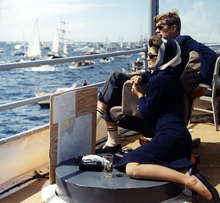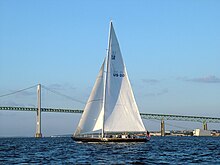History of the America's Cup
Ashbury entered Cambria in the NYYC Queen's Cup race in New York City on 8 August against a fleet of seventeen schooners, with time allowed based on their tonnage.
[13] Although the event ended in acrimony, Ashbury was the catalyst for the introduction of greater fairness in no longer allowing the defender to use multiple yachts against a single challenger.
The small 65 ft (19.81 m) Canadian challenger Atalanta[15] (84 tons, 1881), representing the Bay of Quinte Yacht Club, suffered from lack of funds, unfinished build and a difficult delivery through the Erie Canal from Lake Ontario to New York.
Using steel, tobin bronze, aluminium, and even nickel for novel construction, they significantly lengthened bow and stern overhangs, further extending the sailing waterline as their boats heeled over, thus increasing their hull speed.The next America's Cup challenge was initially limited to 70 ft (21.34 m) waterline in 1889, but the mutual-agreement clauses of a new 1887 Deed of Gift caused the Royal Yacht Squadron to withdraw the Earl of Dunraven's promising Watson designed challenger Valkyrie while she was crossing the Atlantic.
[24] The yachts increased yet again in size, and this time Herreshoff fitted a telescopic steel mast to his defender Columbia, but his largest contribution was to recruit Scottish-American skipper Charlie Barr.
Barr successfully helmed Columbia to victory, and Lipton's noted fair play provided unprecedented popular appeal to the sport and to his tea brand.
To defend the Cup, businessman Thomas W. Lawson funded for Boston designer Bowdoin B. Crowninshield a daring project: his yacht Independence was capable of unrivaled performance because of her extremely long sailing waterline, but she was largely overpowered and unbalanced and suffered from structural issues.
With the aim to fend off Lipton's challenges indefinitely, the NYYC garnered a huge budget for a single cup contender, whose design would be commissioned to Herreshoff again.
Proposing in the same year the Universal Rule, he added the elements of overall length and displacement into the rating, to the benefit of heavy, voluminous hulls and also divided boats into classes, without handicapping sail area.
Lipton turned to Charles Ernest Nicholson for his fourth challenge, and got a superb design under the inauspicious shape of Shamrock IV, with a flat transom.
Barr had died, but his crew manned the Resolute, which faced stiff competition from Vanitie, but went on to win the selection trials, before the Cup was suspended as World War I broke out.
Shamrock IV was crossing the Atlantic with the steam yacht Erin, destined for the British Imperial fortress colony of Bermuda, when Britain declared war on Germany on 5 August 1914.
Nicholson was chosen to design challenger Shamrock V, and despite the Wall Street crash, four NYYC syndicates responded to the threat and built a cup contender each.
[30] The venue was moved to Newport, Rhode Island, where, the Herreshoff Manufacturing Company's new naval architect Starling Burgess used his success in the M-Class and his experience as a wartime plane designer to build the Vanderbilt syndicate's defender Enterprise, the smallest J-Class.
Being steel-plated, she was less disfavoured than Shamrock V, especially after a minimum mast weight limit was set to 5,500 lb (2,500 kg), as this made American duralumin technology less advantageous for this contest.
Endeavour received significant innovations, but Sopwith failed to secure the services of his entire Shamrock V professional crew due to a pay strike.
In 1936, Nicholson designed and built the Endeavour II to the maximum waterline length allowed, and numerous updates to the rig made her even faster than her predecessor.
[33][34] The J-class yachts from the 1930s remained the default for the cup, but post-war economic realities meant that no-one could afford to challenge in this hugely expensive class.
In 1967, another Australian challenger, Dame Pattie, lost to the innovative Olin Stephens design Intrepid, skippered again by Emil Mosbacher (which won again in 1970, to become the second yacht, after Columbia of 1899–1901, to defend the Cup twice).
[citation needed] Sporting the now famous Boxing Kangaroo flag and the controversial winged keel designed by Ben Lexcen, the hull of Australia II was kept under wraps between races and was subject to attempts by the NYYC to disqualify the boat.
The 1983 winner, Australia II, had sported the revolutionary winged keel, and the New Zealand boat that Conner had beaten in the Louis Vuitton Cup final in Fremantle was the first 12-metre class to have a hull of fiberglass, rather than aluminum or wood.
Years later, a less than contrite Conner would say he was "glad" he lost the race as the effort to regain the cup following his loss focused attention from more than just the narrow interest of yachting enthusiasts.
In 1987, soon after Conner had won back the cup with Stars and Stripes but before San Diego Yacht Club had publicly issued terms for the next regatta, a New Zealand syndicate, again led by merchant banker Sir Michael Fay, lodged a surprise challenge.
The court ordered SDYC to accept it and negotiate mutually agreeable terms for a match, or to race under the default provisions of the Deed, or to forfeit the cup to MBBC.
The run-up to the 1995 Cup was notable for the televised sinking of oneAustralia during the fourth round robin of the Louis Vuitton challenger selection series, with all hands escaping uninjured.
At Auckland in 1999–2000, Team New Zealand, led by Sir Peter Blake, and again skippered by Russell Coutts, defeated the Italian Prada Challenge from the Yacht Club Punta Ala.
Globalization made it increasingly difficult to enforce design nationality rules, and starting in 1984, the Royal Perth Yacht Club began relaxing this requirement.
Oracle Team USA was defending the America's Cup 26 May – 27 June 2017 on behalf of the Golden Gate Yacht Club in Bermuda[59] where racing took place on the Great Sound.
When an even smaller 50ft wingsail foiling catamaran class rule amendment was voted in April 2015, Luna Rossa Challenge also withdrew, citing significant costs wasted on the development of the larger vessel.
For the 2021 America's Cup, a new design rule, the "AC75" AC75 was agreed between the Defender (the Royal NZ Yacht Squadron, Emirates Team New Zealand) and the Challenger of Record (Luna Rossa Prada Pirelli).









